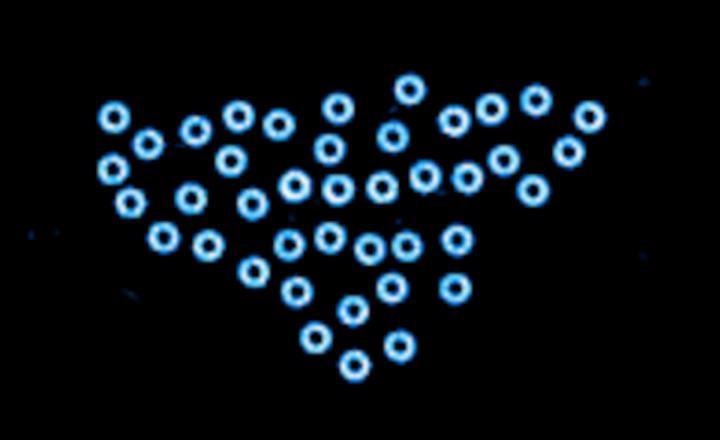Jun 24 2021
A challenging aspect in science and engineering fields is managing matter beyond the thermodynamic equilibrium to develop material systems that can rival those of living organisms.
 When these self-propelled particles come together, they can organize and move like schools of fish to perform robotic functions. Image Credit: Kyle Bishop Lab.
When these self-propelled particles come together, they can organize and move like schools of fish to perform robotic functions. Image Credit: Kyle Bishop Lab.
Studies on active colloids are aiming to develop microscale and nanoscale “particles”, like primitive microorganisms, that swim through viscous fluids. When such self-propelled particles are combined, they organize and move similar to schools of fish to carry out robotic functions, like delivering “cargo” to targeted sites and navigating complex environments.
A Columbia Engineering research team, headed by Kyle Bishop, a professor of chemical engineering, is pioneering the study and design of the dynamics of active colloids, driven by chemical reactions or external electric, magnetic or acoustic fields. The team is designing colloidal robots where active components assemble and interact to carry out dynamic functions inspired by living cells.
Bishop’s team, in association with the Center for Bio-Inspired Energy Science (CBES) at Northwestern University, has reported that they have demonstrated the application of DC electric fields to power the back-and-forth rotation of micro-particles present in electric boundary layers. The study has recently been published in the Physical Review Letters journal.
Such particle oscillators could be used as clocks that synchronize the organization of active matter and may even coordinate the functions of micron-scale robots.
Tiny particle oscillators could enable new types of active matter that combine the swarming behaviors of self-propelled colloids and the synchronizing behaviors of coupled oscillators. We expect interactions among the particles to depend on their respective positions and phases, thus enabling richer collective behaviors — behaviors that can be designed and exploited for applications in swarm robotics.
Kyle Bishop, Professor of Chemical Engineering, Columbia University
Yet, it is not an easy task to create a reliable clock at the micron-scale. As one can visualize, pendulum clocks do not work well when submerged in honey. The periodic motion of these clocks, similar to all inertial oscillators, comes to a halt under adequate resistance from friction. In the absence of inertia, it becomes equally difficult to power the oscillatory movement of micro-scale particles in viscous fluids.
Our recent observation of colloidal spheres oscillating back and forth in a DC electric field presented a bit of mystery, one we wanted to solve. By varying the particle size, field strength, and fluid conductivity, we identified experimental conditions needed for oscillations and uncovered the mechanism underlying the particles’ rhythmic dynamics.
Zhengyan Zhang, Study Lead Author, Columbia University
A PhD student in Bishop’s laboratory, Zhang has discovered this effect.
Previous studies have demonstrated the steady rotation of similar particles through a process called Quincke rotation. Similar to a water wheel filled from above, the Quincke instability is powered by the build-up of electric charge on the surface and the mechanical rotation of the particle in the electric field. But the oscillatory dynamics are not predicted by currently available models of Quincke rotation.
This latest analysis characterizes and describes the “mysterious” oscillations by referring to a boundary layer in the nonpolar electrolyte. Within this often-ignored layer, charge carriers are created that subsequently move away under the effect of the electric field.
Such processes tend to introduce spatial asymmetries in the rates of charge build-up at the surface of the particle. Similar to a water wheel, where buckets empty faster at the top than at the bottom, asymmetric charging can result in back-and-forth rotation at high field strength.
The limited generation rate of charges in these weak electrolytes creates a boundary layer comparable to the size of particle under a strong electric field, as found numerically by my PhD student Hang Yuan, a co-author of the work. As a result, the 'conductivity' of ions around particles that are within the large boundary layer is not constant, leading to the observed oscillations at strong electric fields.
Monica Olvera de la Cruz, Lawyer Taylor Professor, Materials Science and Engineering, Chemistry and (by courtesy) Chemical and Biological Engineering, Physics and Astronomy, Northwestern Engineering
She added, “This work shows a way to generate oscillators, which could lead to the emergence of cooperative phenomena in fluids.”
The researchers tried out various shapes of particles and observed that they could create oscillations with any kinds of particles if their size was similar to that of the boundary layer.
“By tuning the field strength and/or the electrolyte, we can predictably control the frequency of these `Quincke clocks’. Our paper enables the design of new forms of active matter based on collections of mobile oscillators,” added Bishop.
The researchers are now exploring the collective behavior that emerges when several Quincke oscillators move and interact with each other.
Journal Reference:
Zhang, Z., et al. (2021) Quincke Oscillations of Colloids at Planar Electrodes. Physical Review Letters. doi.org/10.1103/PhysRevLett.126.258001.